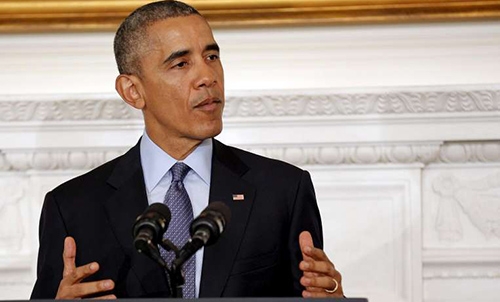Obama presents plan to close Guantanamo prison
President Barack Obama presented a long-shot plan to shutter Guantanamo Bay prison Tuesday, hoping to fulfill an elusive campaign promise before he leaves office next year.
Describing the jail as a stain on America's reputation and a catalyst for jihadists, Obama said "I don't want to pass this problem on to the next president."
"For many years, it's been clear that the detention facility at Guantanamo Bay does not advance our national security. It undermines it," Obama said from the Roosevelt Room.
He outlined a $290-$475 million plan to move the 91 remaining detainees abroad and to one of 13 possible -- unnamed -- facilities in the United States.
Obama has tried for almost eight years to close the jail, but has been thwarted by Congress, his own Department of Defense and some in his own party.
As a candidate and as president, Obama has argued that the detention without trial and torture of orange jumpsuit-clad suspects harms America's image and makes it less safe.
"Keeping this facility open is contrary to our values," he said Tuesday. "It undermines our standing in the world."
"This is about closing a chapter in our history."
Lawmakers in the Republican-controlled Congress have blocked the most obvious path to closing the facility, banning the transfer of detainees to the United States.
The release of Obama's plan is as much an effort to enlist the support of American voters as a possibly utopian effort to convince Republicans to change their minds in the run-up to the November presidential election.
"This plan deserves a fair hearing, even in an election year," Obama said Tuesday.
But Republican Senator and presidential candidate Marco Rubio swiftly hit back with a pledge to increase the Guantanamo population if elected.
"Not only are we not going to close Guantanamo -- When I am president, if we capture a terrorist alive, they are not getting a court hearing in Manhattan. They are not going to be sent to Nevada. They are going to Guantanamo and we are going to find out everything they know."
The US president also has faced opposition from within his own administration, with the Pentagon accused of slow-pedaling transfers and overstating closure costs.
- 'Dangerous precedent' -
The Guantanamo Bay closure plan, which took months to produce, gives few specifics on where a US facility would be, but military officials have previously listed Fort Leavenworth, Kansas or the US Navy brig in Charleston, South Carolina among the possible destinations for inmates.
Those locations, however, face objections from local politicians.
The US leader has long argued that many Guantanamo prisoners should be transferred overseas and some should be tried by military courts.
A small number -- those deemed too dangerous to release but too difficult to prosecute -- would be held in the United States.
Human rights groups worry this would only extend detentions without trial and create a "Guantanamo North."
"The possibility of a new, parallel system of lifelong incarceration inside the United States without charge would set a dangerous precedent," Amnesty International said in a statement.
"If successfully mounted, it would be a devastating blow to basic principles of criminal justice."
The plan says a US facility would save money over time. It currently costs about $455 million each year to run Guantanamo, and a US site would reduce that amount by up to $180 million.
Most of the savings would come from a decrease in the number of troops guarding the reduced population on the US mainland, but it could cost as much as $475 million in one-time expenses to move the men and build or update a facility to hold them.
"However, within three to five years the lower operating costs of a US facility with fewer detainees... could fully offset these transition costs," the closure plan notes.
Efforts to transfer prisoners overseas have been stymied by unrest in Yemen -- a likely destination for many -- and by recidivism among those already released.
Still, Defense Secretary Ashton Carter has in recent weeks signed off on a flurry of transfers, and last month, the prison's population dropped below 100 for the first time.
Today, 91 inmates remain. Of them, 35 have been approved for release. The rest face ongoing, indefinite detention.
Perhaps the most notorious prisoner is Khalid Sheikh Mohammed, who along with four co-defendants is charged with plotting the September 11, 2001 attacks.
The Guantanamo Bay military prison was opened in January 2002 on a US naval base on a coastal spit of land in southeastern Cuba, leased from Havana under a treaty dating back to 1903.
It was set up after the 9/11 attacks under the administration of then-president George W. Bush to deal with prisoners who were termed "enemy combatants" and denied many US legal rights.
Related Posts

